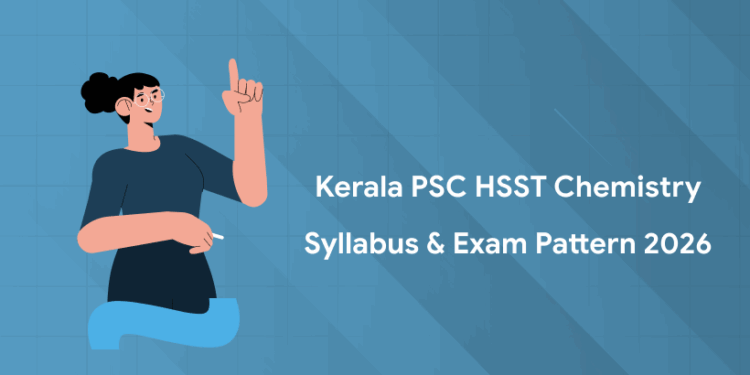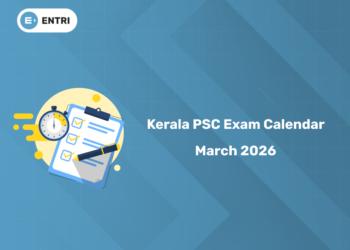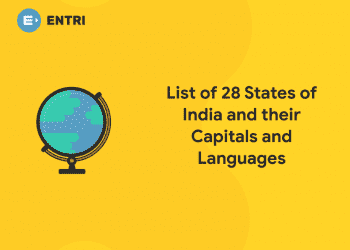Table of Contents
The Kerala PSC is soon releasing the detailed syllabus for the post of Higher Secondary School Teacher (Chemistry) under the Higher Secondary Education Department. In this blog, we provide the latest exam pattern, syllabus PDF, and details to help you prepare thoroughly. The exam consists of 100 objective-type questions, carrying 100 marks, with a total duration of 1 hour 30 minutes. Explore the details here!
Kerala PSC HSST Chemistry Recruitment 2026 Highlights
| Kerala PSC HSST Chemistry Notification 2026 | |
| Job Type | Government Job |
| Post Name | Higher Secondary School Teacher |
| Category Number | Notify Later |
| Subject | Chemistry |
| Notification Release Date | Notify Later |
| Application Starts | Notify Later |
| Apply Mode | Online |
| Last Date to Apply | Notify Later |
| Official Website | www.keralapsc.gov.in |
Kerala PSC HSST Chemistry Syllabus 2026 PDF Download
1: The first recipient of the ‘Rajiv Gandhi Khel Ratna’ award?
You can download the Kerala PSC HSST Chemistry Syllabus 2026 PDF from the link below. The syllabus covers all main areas like Inorganic, Organic, Physical, Analytical, Environmental, Material, and Supramolecular Chemistry, along with Teaching Aptitude and other related subjects. Get the PDF now!
Enroll in Kerala's Top-rated HSA Coaching Program!
സർക്കാർ ജോലി എന്ന സ്വപ്നം ഇനി സ്വപ്നം മാത്രമല്ല! Join Entri's HSA Coaching Program
Join Now!Kerala PSC HSST Chemistry Exam Pattern 2026
| Part | Module / Section | Main Topics / Areas Covered | Marks |
|---|---|---|---|
| Part I | Module 1 | Inorganic Chemistry – 1 | 10 |
| Module 2 | Inorganic Chemistry – 2 | 10 | |
| Module 3 | Organic Chemistry – 1 | 10 | |
| Module 4 | Organic Chemistry – 2 | 10 | |
| Module 5 | Physical Chemistry – 1 | 10 | |
| Module 6 | Organic Chemistry – 3 | 8 | |
| Module 7 | Physical Chemistry – 2 | 5 | |
| Module 8 | Physical Chemistry – 3 | 5 | |
| Module 9 | Analytical, Environmental, Material & Supramolecular Chemistry | 7 | |
| Total for Part I | Core Chemistry Modules (1–9) | 75 Marks | |
| Part II | I. Teaching Aptitude | Nature, objectives, factors affecting teaching, methods, aids, evaluation | 5 |
| II. Research Aptitude | Research meaning, types, ethics, steps, thesis writing, seminars | 5 | |
| Part III | Indian Constitution | Salient features, rights, duties, centre–state relations, amendments | 5 |
| Social Welfare Legislations & Programmes | RTI, Environmental Acts, Employment Guarantee, Welfare Schemes | 5 | |
| Part IV | Renaissance in Kerala | Reform movements, social revolts, press, literature, women, leaders | 5 |
| General Knowledge & Current Affairs | General awareness and current events | 5 | |
| Total for Parts II–IV | Teaching, Research, Constitution, GK, Renaissance | 30 Marks |
Kerala PSC HSST Chemistry Detailed Syllabus 2026
Check the complete Kerala PSC HSST Chemistry Syllabus 2026 here. The syllabus covers Inorganic, Organic, Physical, Analytical, Environmental, and Material Chemistry along with Teaching Aptitude, Research Methodology, Constitution, and Renaissance in Kerala.
PART I
Module 1 (8 Marks)
Inorganic Chemistry – 1
Structure and bonding in molecules – Chemical periodicity – Chemistry of Hydrogen and s-block elements – Chemistry of p-block elements and d-block elements – Extractive chemistry of various metals of commercial importance – Chemistry of Non-transition elements like Glass.
Theories of acids and bases – HSAB concept – Solvent effects, linear free energy relationship – Mechanism and methods of determination, super acids – Reactions in non-aqueous solvents: protic and aprotic solvents – Chemistry of isopoly and heteropoly acids; silicon-oxygen compounds; zeolites; xenon and krypton compounds including their organic and coordination compounds.
Synthesis, reactions, structure, and bonding in sulphur–nitrogen compounds; sulphur–phosphorus compounds; phosphorus–nitrogen compounds; boron–nitrogen compounds; boron hydrides; organoboranes; carboranes and metallocarboranes – STYX and WADE rules.
Chemistry of lanthanides and actinides including their extraction and applications as well as their coordination complexes and spectral behaviour.
Theories of coordination chemistry in detail: Werner’s theory – Crystal field theory – Ligand field theory – Molecular orbital theory – Stereochemistry of coordination compounds – Jahn–Teller distortion – Detailed study of stability and reactions of metal complexes – Electron transfer, substitution, and photochemical reactions and their kinetics.
Module 2 (8 Marks)
Inorganic Chemistry – 2
Construction of energy level diagrams. Correlation diagram. Method of descending symmetry. Term symbols; correlation diagrams for dn and d10 ions in octahedral and tetrahedral fields; Orgel and Tanabe–Sugano diagrams. Symmetry and selection rules for electronic spectra, IR and Raman.
Theory of electronic, IR, NMR, ESR, and Mössbauer spectra of complexes. Different aspects of magnetic properties of complexes and their determination.
Spectroscopic methods in inorganic chemistry – Structural elucidation of coordination compounds containing the following molecules/ions as ligands: NH₃, H₂O, CO, NO, OH⁻, SO₂, CN⁻, SCN⁻, NO₂⁻, CH₃COO⁻, and X⁻ (X = halogen). Changes in ligand vibration on coordination with metal ions – CD and ORD spectra of metal complexes – NMR of metal nuclides with emphasis on ¹¹B, ³¹P, and ¹⁹F NMR – ESR spectra: application to Cu(II) complexes and inorganic free radicals such as PH₄, F⁻, and [BH₄]⁻ – Mössbauer spectroscopy: application of the technique to the studies of iron and tin complexes.
Nomenclature, synthesis, structure, properties, and bonding of organometallic compounds – Metal carbonyls and cyanides – Complexes with linear π donor ligands: olefins, acetylenes, dienes, and allyl complexes – Complexes with cyclic π donors: cyclopentadiene and benzene complexes – Structure and bonding of ferrocene and dibenzenechromium complexes – Metal–metal bonds and metal atom clusters – Tri-, tetra-, and hexa-nuclear clusters – Isoelectronic and isolobal relationships – Low nuclearity and high nuclearity carbonyl clusters (LNCCs and HNCCs) – Cubane clusters, chalcogenide clusters, Chevrel phases, Zintl anions and cations – Capping rule – Catalysis by organometallic compounds and metal clusters: hydrogenation, hydroformylation, and polymerization.
Essential and trace metal elements in biological systems. Role of iron, calcium, copper, lithium, aluminium, magnesium, and other metals in biological systems; structure and functions of biological membranes; mechanism of ion transport across membranes; sodium–potassium pump. Role and effects of coenzymes, cytochromes, chlorophylls, and hormones. Photosynthesis, porphyrin ring system, chlorophyll, PS I and PS II, synthetic model for photosynthesis. Inorganic medicinal chemistry – Metals in medicine.
Module 3 (8 Marks)
Inorganic Chemistry – 3
Nuclear reactions – Structure and stability – Magic numbers – Detailed study of different nuclear models – Radioactive equilibria and equations of radioactive decay and growth – Nuclear reactions: direct nuclear reactions, heavy ion-induced nuclear reactions, photonuclear reactions. Neutron capture cross-section and critical size – Applications of nuclear reactions: fission and fusion; neutron activation analysis – Counting techniques.
Solid State Chemistry: Crystal symmetry – Point groups and space groups – Miller indices and Bravais lattices – Close-packed structures: BCC, FCC, and HCP – Voids – Coordination number – X-ray diffraction by crystals: applications and calculations using Bragg’s equation and indexing methods – Different types of crystal defects and consequences.
Electronic structure of solids – Different theories about conductors, insulators, and semiconductors and their applications – Doping and band gap adjustments – AX, AX₂, AmX₂, ABX₃, spinels, and inverse spinel structures – Structure and theories of liquids – Liquid crystals and their applications.
Temperature dependence of conductivity, carrier density, and carrier mobility in semiconductors – Superconductivity, photoconductivity, photovoltaic effect.
Colour in inorganic solids – Dielectric properties – Dielectric materials – Ferroelectricity, pyroelectricity, piezoelectricity, and ionic conductivity – Applications of ferro-, piezo-, and pyroelectrics.
Inorganic Advanced Materials: Solid electrolytes: mixed oxides, cationic, anionic solid electrolytes, mixed ionic–electronic conductors – Solid oxide fuel cells (SOFC), rechargeable battery materials – Solid-state chemistry of metal nitrides and fluorides, chalcogenides, intercalation chemistry, and metal-rich phases – Inorganic pigments, inorganic phosphors, molecular materials and fullerides – Basic idea of molecular materials chemistry like one-dimensional metals, molecular magnets, and inorganic liquid crystals.
Module 4 (8 Marks)
Organic Chemistry – 1
Nomenclature of organic compounds – Cyclic, fused polycyclic, and bridged polycyclic hydrocarbons; bridged and fused hydrocarbon systems; spirocyclic hydrocarbon systems; heterocyclic systems containing nitrogen and oxygen.
Molecular symmetry and chirality, axial chirality, planar chirality, and helicity, relative configuration, stereochemical nomenclature, R and S, E and Z. Stereochemistry of biphenyls and allenes – Topicity and prostereoisomerism – Asymmetric synthesis. Axial stereochemistry: atropisomerism and its designation – Biphenyls, allenes, spiranes – M and P configurations.
Stereoselectivity: enantioselectivity, diastereoselectivity, and stereoconvergence. Stereospecific and stereoselective synthesis. Stereotopicity and stereoprojections. Prochiral centre and prochiral faces – Pro R and Pro S, Re face and Si face – Importance of prochirality in biological systems.
Geometrical isomerism. Conformational analysis in acyclic and cyclic systems. Application of Cram’s rule, Felkin–Ahn model.
Basic concepts of organic reactions – Electron displacement effects – Aromaticity and antiaromaticity. Non-aromatic, homoaromatic, hetero, and non-benzenoid aromatic systems. Aromaticity of annulenes, mesoionic compounds, metallocenes, cyclic carbocations, and carbanions.
Mechanism and applications of common substitution, addition, elimination, and rearrangement reactions. Stereochemistry and factors affecting aliphatic and aromatic SN1 and SN2 reactions. SN1′, SN2′, SNi, SNAr, and benzyne mechanisms – NGP and nonclassical carbocations – Generation and reactions of nitrenes, carbenes, and free radicals like triphenylmethyl, TEMPO, dibenzoyl peroxide, NBS, tributyl tin hydride, and AIBN – Chlorination of alkanes, addition of HX, SRN1 mechanism – Acyloin condensation, alkyne coupling reactions, Reimer–Tiemann, Vilsmeier–Haack, Mitsunobu, and Chichibabin reactions.
Mechanism of addition of H₂O, X₂, HX, and boranes to C=C systems – Cis and trans hydroxylation of cycloalkenes – Mechanism and applications of Michael addition and Robinson annulation – Aldol condensation – Stork enamine, Cannizzaro, Perkin, Ritter, Stobbe, Knoevenagel, Darzen, Reformatsky, and benzoin condensations – Grignard, Mannich, Thorpe reactions, and Dieckmann condensation.
Mechanism and regio- and stereo-aspects of E1, E2, and E1cb reactions in cyclic and acyclic systems – Hofmann and Saytzeff elimination – Elimination vs substitution – Mechanism and applications of Shapiro reaction, Peterson and Julia olefination, Wittig and Wittig–Horner reactions; Chugaev reaction and Cope eliminations – Sodium in liquid ammonia and Lindlar’s catalyst in conversion of alkynes to alkenes.
Module 5 (8 Marks)
Organic Chemistry – 2
Mechanism with evidence of Wagner–Meerwein, Pinacol, Demjanov, Hofmann, Curtius, Schmidt, Lossen, Beckmann, Fries, Hofmann–Martius, Dienone–Phenol,
Benzilic acid, Benzidine, Favorskii, Stevens, and Wolff rearrangement.
Oxidation and reduction reactions in organic synthesis – Reduction using boranes, hindered boranes and derivatives – NaBH₄ and LiAlH₄, DIBAL-H, tri-n-butyltin hydride, diimide, and aluminium alkoxide – Birch reduction, Clemmensen reduction, and Wolff–Kishner reduction, Huang–Minlon modification, Rosenmund reduction – Allylic and benzylic oxidation, Sharpless epoxidation, oxidation using SeO₂, manganese(IV) oxide, lead tetraacetate, ozone, peracids, DDQ, silver carbonate, and Cr(VI) reagents – Jones oxidation, Swern oxidation, Moffatt oxidation, Sommelet reaction – Applications of HIO₄, OsO₄, and mCPBA.
Linear free energy relations – The Hammett equation and its applications – Significance of sigma (σ) and rho (ρ) – Reactions with negative and positive ρ, low and high ρ, abnormal Hammett plot – Taft equation – Hammett plot and applications – Primary, secondary, inverse kinetic isotope effects – Salt effects and special salt effects in SN reactions.
Retrosynthetic analysis and disconnection approach in organic synthesis – Olefin metathesis – Grubbs’ catalysts – Umpolung concept – 1,3-Dithiane, benzoin condensation – Heck, Negishi, Sonogashira, Kumada, Stille, and Suzuki coupling.
Use of various organic, inorganic, and organometallic reagents in organic synthesis – Grignard reagents, alkyl lithiums, lithium dialkylcuprates, alkynyl copper reagents, Tebbe reagent, etc. Use of various protecting groups in peptide synthesis. Phase transfer catalysis and its applications.
Module 6 (8 Marks)
Organic Chemistry – 3
Photochemical processes – Singlet and triplet states and their reactivity, Jablonski diagram, energy transfer, sensitization, and quenching. Photoreactions of carbonyl compounds, enes, dienes, and arenes – Paternò–Büchi and Barton reactions, Hofmann–Löffler–Freytag reaction, photo-Fries and di-π-methane rearrangements. Applications of photochemistry.
Classification of pericyclic reactions – FMO, correlation diagram, Möbius and Hückel theory of electrocyclic and cycloaddition reactions – Stereo- and regioselectivity and industrial applications of Diels–Alder reaction, 1,3-dipolar cycloaddition, and sigmatropic rearrangements.
Chemistry of Natural Products: Terpenes, steroids, alkaloids, carbohydrates, proteins, nucleic acids, vitamins, prostaglandins, hormones, and enzymes.
Combinatorial organic synthesis – Introduction, methodology, automation, solid-supported and solution-phase synthesis – Study of targeted or focused libraries and small-molecule libraries.
Application of drug design and development – Various steps.
Fundamentals of polymerization – Structure–property relationship of polymers and polynucleotides – Protein sequencing by Edman’s method.
Protein denaturation – Synthesis of stereoregular polymers – Ziegler–Natta catalyst – Polymers in organic synthesis: supports, reagents, and catalysts – Biodegradable polymers, biopolymers.
Spectroscopic methods in organic chemistry – Applications of UV, IR, ¹H NMR, ¹³C NMR, and mass spectroscopy – 2D NMR techniques: NOE, DEPT, and 2D techniques such as COSY, HSQC, HMQC, and HMBC – Spectral interpretation and structural elucidation – Solving of structural problems on the basis of numerical and spectrum-based data – ORD and CD: theory and applications.
Module 7 (5 Marks)
Physical Chemistry – 1
Gaseous state – Maxwell’s distribution and equation – Transport phenomena – Chapman equation – Equations of state of real gases: van der Waals, virial, and other equations – Intermolecular forces and consequences.
Electronic structure of solids – Crystal symmetry – Theories of solids – Properties of solids: electrical, magnetic, and optical – Crystal defects – Structure and theories of liquids – XRD of liquids – Theories and calculation of surface tension and viscosity – Liquid crystals and their applications.
Laws of thermodynamics – Entropy and its dependence on variables of a system – Equations of state – Euler’s relation, Gibbs and Helmholtz equations and energies – Maxwell’s relations – Gibbs–Duhem equation – Partial molar quantities – Chemical potential – Fugacity – Activity coefficients.
Thermodynamics of solutions – Duhem–Margules equation – van’t Hoff’s equations, isochore and isotherm. Thermodynamics of irreversible processes – Fundamentals and advances in the study of phase equilibria – Two- and three-component systems.
Statistical thermodynamics – Molecular partition function – Quantum statistics – Heat capacities of solids and gases – Relationship between partition functions and thermodynamic properties – Sackur–Tetrode equation – The principle of equipartition of energy.
Chemical equilibrium, law of mass action, transformation of equilibrium expressions – Statistical derivation.
Module 8 (5 Marks)
Physical Chemistry – 2
The gas–solid interface – Types of adsorption – Monolayer and multilayer adsorption – Adsorption isotherms – Heat of adsorption and its determination – Adsorption from solutions – Determination of surface area of solids: Harkins–Jura absolute method, point B method, Langmuir method, and BET method – Principles of LEED, SEM, TEM, ECSA, photoelectron spectroscopy, scanning probe microscopy, Auger electron spectroscopy.
Electrochemistry and Ionics: Activity and activity coefficient of electrolytes, determination of activity coefficient – Electrodes and electrochemical cells – Nernst, Debye–Hückel, Onsager equations – Overpotentials: Butler–Volmer equation, Tafel and Nernst equations, Tafel plot and its significance – Electrolytic polarization – Fuel cells: H₂–O₂, zinc–air, and solid oxide fuel cells – Theory and applications of electroanalytical methods: potentiometry, polarography, coulometry, conductometry, cyclic voltammetry, stripping voltammetry, and amperometry – Colloids – Zeta potential – Electrokinetic phenomena.
Basic principles of kinetics – Kinetics of complex reactions – Steady-state approximation – Theories of reaction rates – Arrhenius equation – Fast reactions and methods of study – Reactions in solution: factors affecting reaction rates in solutions, effect of dielectric constant and ionic strength, cage effect, Brønsted–Bjerrum equation – Kinetic effects: primary and secondary kinetic salt effect, influence of solvent on reaction rates, significance of volume of activation, linear free energy relationship – Hammett and Taft equations.
Catalysis: Mechanism and theories of homogeneous and heterogeneous catalysis – Bimolecular surface reactions – Langmuir–Hinshelwood mechanism – Enzyme catalysis.
Module 9 (5 Marks)
Physical Chemistry – 3
Classical mechanics and its limitations – Need of quantum mechanics, de Broglie relation and its experimental proof, uncertainty principle and its consequences – Formulation of quantum mechanics – Postulates of quantum mechanics – Application of quantum mechanics to exactly solvable model problems – Translational motion – Quantum mechanical tunnelling – Vibrational motion and rotational motion – SHO, rigid rotor – Legendre polynomials and associated Legendre functions.
Approximation methods and chemical bonding – Hydrogen-like atoms – Multi-electron systems – Angular momentum – SCF and variation method – MO diagram of homonuclear diatomic molecules Li₂, Be₂, B₂, C₂, O₂, and F₂, and heteronuclear diatomic molecules LiH, CO, NO, and HF.
Wave functions for multi-electron systems, wave equation for multi-electron systems, symmetric and antisymmetric wave functions, Pauli’s antisymmetry principle, and the postulate of spin – Spin orbitals – Spin–orbit coupling – Vector atom model – Term symbols, selection rules, and explanation of spectral lines of hydrogen atom – Applications – Chemical bonding in diatomic and polyatomic molecules.
Computational Chemistry: Computational methods – ab initio, semi-empirical methods – Molecular mechanics.
Quantum statistics – Bose–Einstein statistics, thermodynamic probability – Maxwell–Boltzmann, Bose–Einstein, and Fermi–Dirac statistics – Quantum theory of heat capacity – Calculation of heat capacity of gases – Dulong and Petit’s law, Kopp’s law; limitations – Einstein theory and Debye theory of heat capacity.
Symmetry elements and symmetry operations – Basic principles of group theory – Character tables – Point groups and their systematic identification – Multiplication of operations – Setting up of character table of C₂v, C₃v, and C₂h groups – Applications to MO theory, chemical bonding, and spectroscopy.
Electronic spectroscopy of atoms – Basic principles of molecular spectroscopy: microwave, infrared, Raman, electronic, NMR, ESR, Raman, and Mössbauer.
Module 10 (7 Marks)
Analytical, Environmental, Material and Supramolecular Chemistry
Evaluation of analytical data: Accuracy and precision – Standard deviation, variance, and coefficient of variation – Student’s t-test, Q-test, and F-test – Confidence limits – Errors and their minimisation – Significant figures – Correlation analysis – Calculation of R by method of least squares.
Theory and practice of quantitative and qualitative analysis – Inorganic analysis, organic analysis and preparations – Physical chemistry experiments (postgraduate level).
Applications of TG, DTA, and DSC in the study of metal complexes, ceramics, and polymers.
Theory of chromatographic techniques – Column, TLC, paper, GC, HPLC, and ion-exchange chromatographic techniques – Solvent extraction – Extraction using supercritical liquid CO₂ – Craig’s technique of liquid–liquid extraction.
Twelve principles of green chemistry and issues in sustainable chemistry – Green synthesis – Application of phase transfer catalysts – Green reactions – Applications of microwave and sonication in the synthesis of organic compounds.
Chemistry of atmosphere, hydrosphere, and lithosphere.
Nanostructures – 1D, 2D, and 3D structures – Synthesis and applications of nanomaterials.
Chemistry behind piezoelectric, magnetostrictive, halochromic, chromogenic, electrochromic, thermochromic, magnetocaloric, and thermoelectric materials.
Supramolecular Chemistry: Molecular recognition – Synthetic receptors, cyclodextrins, calixarenes, cyclophanes, crown ethers – Drug design and drug action.
PART II
RESEARCH METHODOLOGY / TEACHING APTITUDE
I. TEACHING APTITUDE (5 Marks)
- Teaching: Nature, objectives, characteristics and basic requirements.
- Learner’s characteristics.
- Factors affecting teaching.
- Methods of teaching.
- Teaching aids.
- Evaluation systems.
II. RESEARCH APTITUDE (5 Marks)
- Research: Meaning, characteristics and types.
- Steps of research.
- Methods of research.
- Research ethics.
- Paper, article, workshop, seminar, conference and symposium.
- Thesis writing: its characteristics and format.
PART III
Salient Features of Indian Constitution (5 Marks)
Salient features of the Constitution – Preamble – Its significance and its place in the interpretation of the Constitution.
Fundamental Rights – Directive Principles of State Policy – Relation between Fundamental Rights and Directive Principles – Fundamental Duties.
Executive – Legislature – Judiciary – Both at Union and State Level – Other Constitutional Authorities.
Centre-State Relations – Legislative, Administrative and Financial.
Services under the Union and the States.
Emergency Provisions.
Amendment Provisions of the Constitution.
Social Welfare Legislations and Programmes (5 Marks)
Social Service Legislations like Right to Information Act, Prevention of Atrocities against Women & Children, Food Security Act, Environmental Acts etc. and Social Welfare Programmes like Employment Guarantee Programme, Organ and Blood Donation etc.
PART IV
RENAISSANCE IN KERALA (5 Marks)
TOWARDS A NEW SOCIETY
Introduction to English education – Various missionary organisations and their functioning – Founding of educational institutions, factories, printing press etc.
EFFORTS TO REFORM THE SOCIETY
(A) Socio-Religious Reform Movements
SNDP Yogam, Nair Service Society, Yogakshema Sabha, Sadhu Jana Paripalana Sangham, Vaala Samudaya Parishkarani Sabha, Samathwa Samajam, Islam Dharma Paripalana Sangham, Prathyaksha Raksha Daiva Sabha, Sahodara Prasthanam etc.
(B) Struggles and Social Revolts
Upper cloth revolts, Channar agitation, Vaikom Sathyagraha, Guruvayoor Sathyagraha, Paliyam Sathyagraha, Kuttamkulam Sathyagraha, Temple Entry Proclamation, Temple Entry Act, Malayalee Memorial, Ezhava Memorial etc.
Malabar riots, Civil Disobedience Movement, Abstention Movement etc.
ROLE OF PRESS IN RENAISSANCE
Malayalee, Swadeshabhimani, Vivekodayam, Mithavadi, Swaraj, Malayala Manorama, Bhashaposhini, Mathrubhoomi, Kerala Kaumudi, Samadarsi, Kesari, Al-Ameen, Prabhatham, Yukthivadi etc.
AWAKENING THROUGH LITERATURE
Novel, Drama, Poetry, Purogamana Sahithya Prasthanam, Nataka Prasthanam, Library Movement etc.
WOMEN AND SOCIAL CHANGE
Parvathi Nenmenimangalam, Arya Pallam, A. V. Kuttimalu Amma, Lalitha Prabhu, Akkamma Cheriyan, Anna Chandi, Lalithambika Antharjanam and others.
LEADERS OF RENAISSANCE
Thycaud Ayya Vaikundar, Sree Narayana Guru, Ayyan Kali, Chattampi Swamikal, Brahmananda Sivayogi, Vagbhadananda, Poikayil Yohannan (Kumara Guru), Dr. Palpu, Palakkunnath Abraham Malpan, Mampuram Thangal, Sahodaran Ayyappan, Pandit K. P. Karuppan, Pampadi John Joseph, Mannathu Padmanabhan, V. T. Bhattathirippad, Vakkom Abdul Khadar Maulavi, Makthi Thangal, Blessed Elias Kuriakose Chavara, Barrister G. P. Pillai, T. K. Madhavan, Moorkoth Kumaran, C. Krishnan, K. P. Kesava Menon, Dr. Ayyathan Gopalan, C. V. Kunjuraman, Kuroor Neelakantan Namboothiripad, Velukkutty Arayan, K. P. Vellon, P. K. Chathan Master, K. Kelappan, P. Krishna Pillai, A. K. Gopalan, T. R. Krishnaswami Iyer, C. Kesavan, Swami Ananda Theerthan, M. C. Joseph, Kuttippuzha Krishnapillai and others.
LITERARY FIGURES
Kodungallur Kunhikkuttan Thampuran, Kerala Varma Valiyakoyi Thampuran, Kandathil Varghese Mappila, Kumaran Asan, Vallathol Narayana Menon, Ulloor S. Parameswara Iyer, G. Sankara Kurup, Changampuzha Krishna Pillai, Chandu Menon, Vaikom Muhammad Basheer, Kesav Dev, Thakazhi Sivasankara Pillai, Ponkunnam Varkey, S. K. Pottakkad and others.
GENERAL KNOWLEDGE AND CURRENT AFFAIRS (5 Marks)
General Knowledge and Current Affairs.
How to Download Kerala PSC HSST Chemistry Syllabus 2026 PDF
- Visit the official Kerala PSC website – https://www.keralapsc.gov.in
- Go to the “Downloads” section on the homepage.
- Click on “Syllabus”.
- Choose “Subject-wise Syllabus” from the list.
- Search for “Higher Secondary School Teacher – Chemistry” or use the code (if available).
- Click the download icon next to the syllabus link.
- The PDF will open – select “Save” or “Download” to store it on your device.












